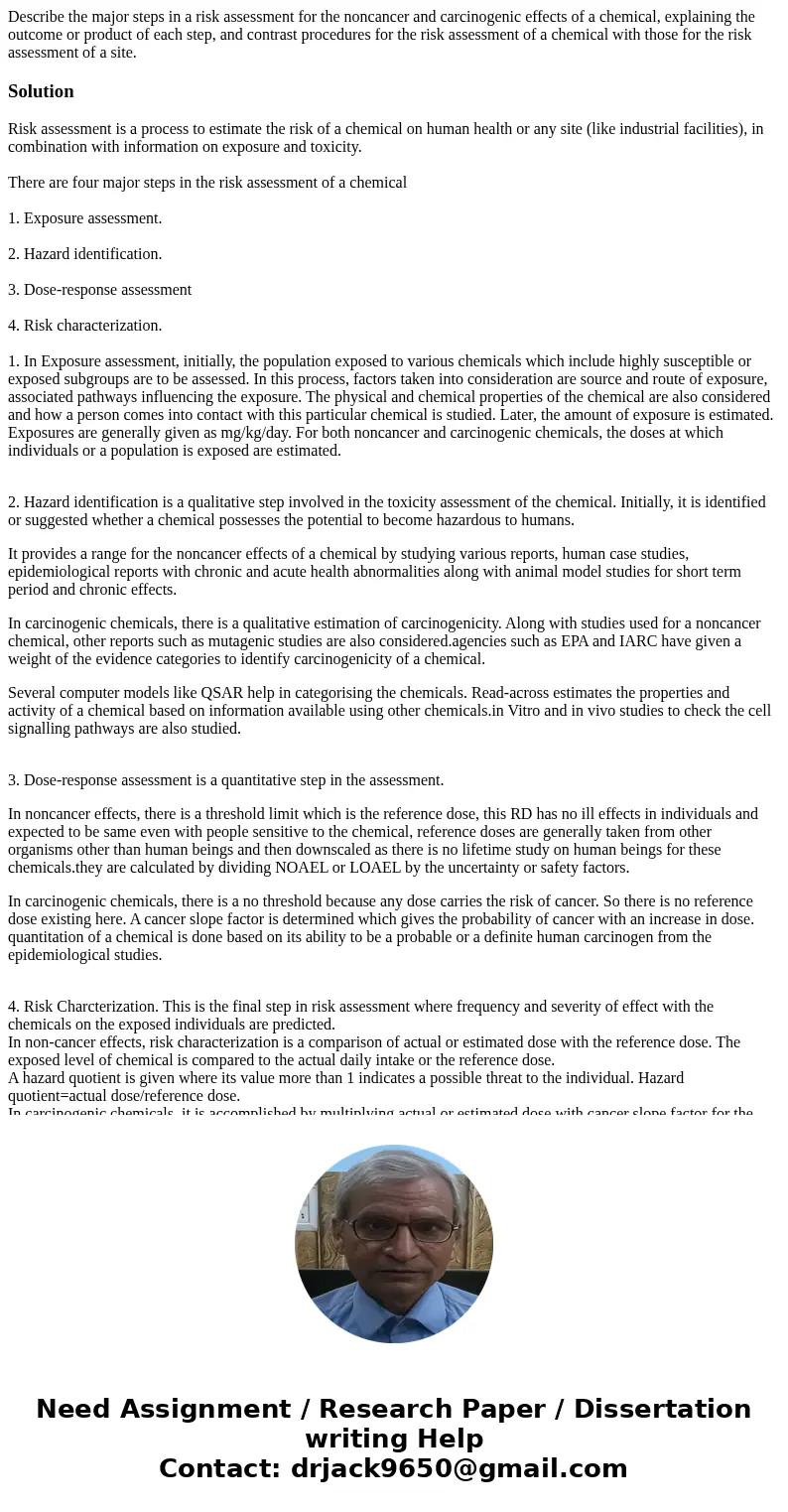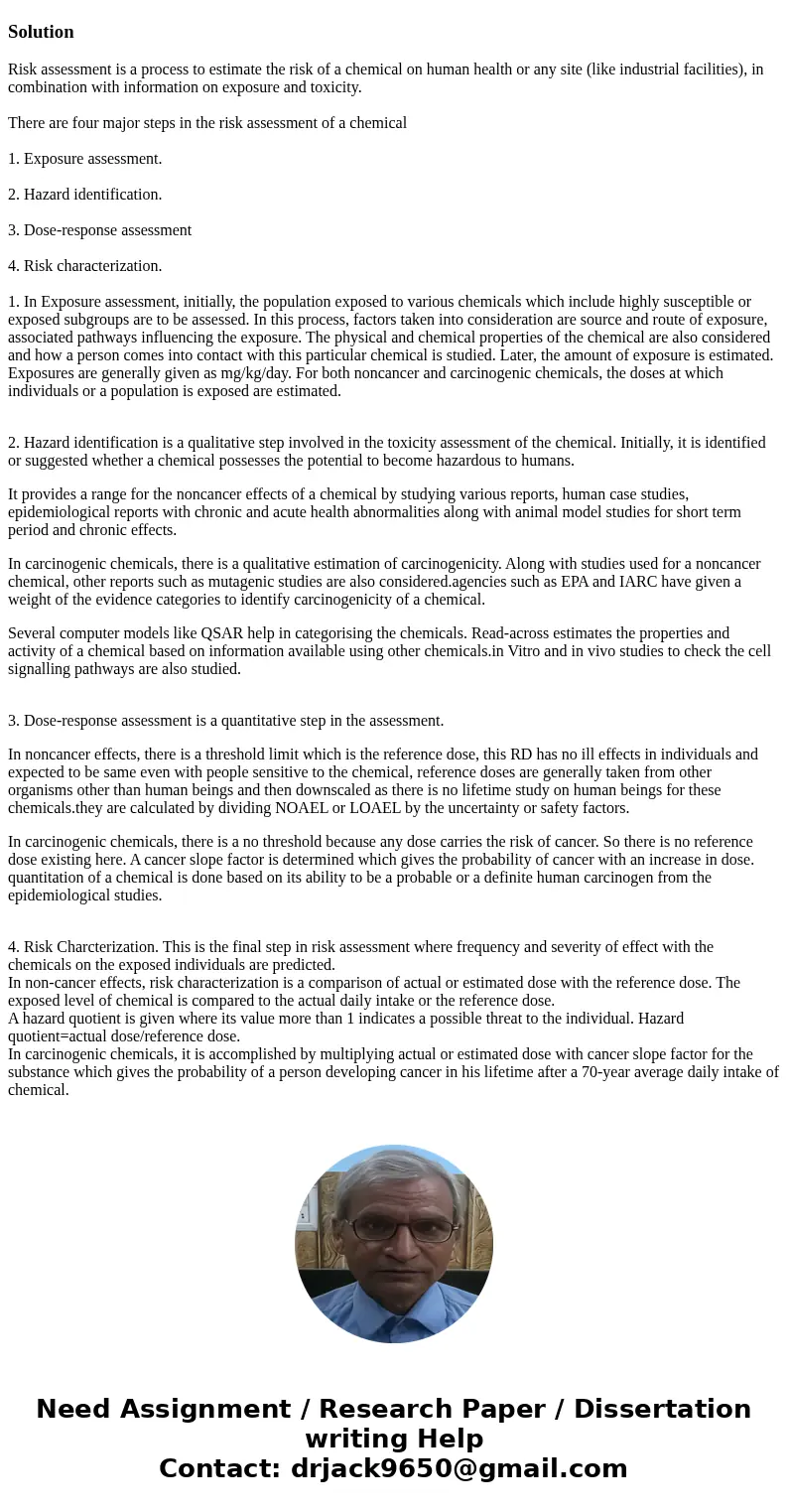Describe the major steps in a risk assessment for the noncan
Describe the major steps in a risk assessment for the noncancer and carcinogenic effects of a chemical, explaining the outcome or product of each step, and contrast procedures for the risk assessment of a chemical with those for the risk assessment of a site.
Solution
Risk assessment is a process to estimate the risk of a chemical on human health or any site (like industrial facilities), in combination with information on exposure and toxicity.
There are four major steps in the risk assessment of a chemical
1. Exposure assessment.
2. Hazard identification.
3. Dose-response assessment
4. Risk characterization.
1. In Exposure assessment, initially, the population exposed to various chemicals which include highly susceptible or exposed subgroups are to be assessed. In this process, factors taken into consideration are source and route of exposure, associated pathways influencing the exposure. The physical and chemical properties of the chemical are also considered and how a person comes into contact with this particular chemical is studied. Later, the amount of exposure is estimated. Exposures are generally given as mg/kg/day. For both noncancer and carcinogenic chemicals, the doses at which individuals or a population is exposed are estimated.
2. Hazard identification is a qualitative step involved in the toxicity assessment of the chemical. Initially, it is identified or suggested whether a chemical possesses the potential to become hazardous to humans.
It provides a range for the noncancer effects of a chemical by studying various reports, human case studies, epidemiological reports with chronic and acute health abnormalities along with animal model studies for short term period and chronic effects.
In carcinogenic chemicals, there is a qualitative estimation of carcinogenicity. Along with studies used for a noncancer chemical, other reports such as mutagenic studies are also considered.agencies such as EPA and IARC have given a weight of the evidence categories to identify carcinogenicity of a chemical.
Several computer models like QSAR help in categorising the chemicals. Read-across estimates the properties and activity of a chemical based on information available using other chemicals.in Vitro and in vivo studies to check the cell signalling pathways are also studied.
3. Dose-response assessment is a quantitative step in the assessment.
In noncancer effects, there is a threshold limit which is the reference dose, this RD has no ill effects in individuals and expected to be same even with people sensitive to the chemical, reference doses are generally taken from other organisms other than human beings and then downscaled as there is no lifetime study on human beings for these chemicals.they are calculated by dividing NOAEL or LOAEL by the uncertainty or safety factors.
In carcinogenic chemicals, there is a no threshold because any dose carries the risk of cancer. So there is no reference dose existing here. A cancer slope factor is determined which gives the probability of cancer with an increase in dose. quantitation of a chemical is done based on its ability to be a probable or a definite human carcinogen from the epidemiological studies.
4. Risk Charcterization. This is the final step in risk assessment where frequency and severity of effect with the chemicals on the exposed individuals are predicted.
In non-cancer effects, risk characterization is a comparison of actual or estimated dose with the reference dose. The exposed level of chemical is compared to the actual daily intake or the reference dose.
A hazard quotient is given where its value more than 1 indicates a possible threat to the individual. Hazard quotient=actual dose/reference dose.
In carcinogenic chemicals, it is accomplished by multiplying actual or estimated dose with cancer slope factor for the substance which gives the probability of a person developing cancer in his lifetime after a 70-year average daily intake of chemical.


 Homework Sourse
Homework Sourse